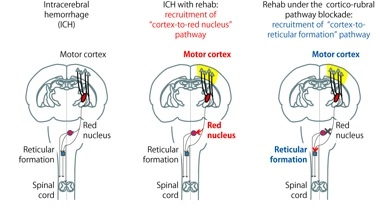Dynamic reorganization of brain circuit with post-stroke rehabilitation
September 13,2019
Nagoya City University (NCU) researchers have revealed an interaction between cortico-brainstem pathways during training-induced recovery in stroke model rats, providing valuable insights for improving rehabilitation methods. Upper limb hemiparesis often occurs after ischemic or hemorrhagic stroke. Unilateral upper extremity impairment can substantially disturb patients' ability to complete activities of daily living. Therefore, continuous improvement of rehabilitation methods is needed to achieve more positive long-term outcomes among survivors.
Researchers at NCU have identified the dynamic recruitment of the "cortex-to-brainstem" pathways via post-stroke intensive rehabilitation and its contribution to the recovery of impaired forelimb function in intracerebral hemorrhage (ICH) model rats. This crucial finding could provide new insights enabling the improvement of rehabilitative methods for humans.
Stroke often affects the primary network from the cortex to the spinal cord, causing severe ongoing motor deficits. Rehabilitation promotes the recovery of impaired motor function, which is believed to be due to reorganization of the residual neural circuits. However, how the circuits are recruited in rehabilitation-induced recovery remains unclear.
To investigate the mechanisms underlying these phenomena, the NCU team used an ICH rat model in which almost 90% of the cortico-spinal tract is destroyed, causing changes in other motor-related circuits. "We previously found abundant newly formed connections from the motor cortex to the red nucleus in rehabilitated rats," first author Akimasa Ishida explains. "Interestingly, we also uncovered an increase in the "cortex-to-reticular formation" pathway in trained rats when the "cortico-to-red nucleus" pathway failed to function, using a double-viral infection technique during rehabilitation."
To test the contribution of the newly-increased cortex-to-reticular formation connections to functional recovery, the researchers selectively blocked the target pathway using a double-viral infection technique in rats under blockade of the cortex-to-red nucleus pathway during rehabilitation. When the cortex-to-reticular formation connections were silenced, impaired forelimb function reappeared in rehabilitated rats.
These results demonstrate that the rapid recruitment of the cortex-to-brainstem pathways is a key factor for functional recovery in intensive rehabilitation. "We provided clear evidence that the dynamic compensatory recruitment of residual circuits occurred when other responsible motor circuits failed to function," said corresponding author Hideki Hida. "This evidence indicates the remarkable flexibility of injured brains, and further investigation of the details of the "switching" process will be helpful for the development of more effective rehabilitation methods."
Nagoya City University (NCU) researchers have revealed an interaction between cortico-brainstem pathways during training-induced recovery in stroke model rats, providing valuable insights for improving rehabilitation methods. Upper limb hemiparesis often occurs after ischemic or hemorrhagic stroke. Unilateral upper extremity impairment can substantially disturb patients' ability to complete activities of daily living. Therefore, continuous improvement of rehabilitation methods is needed to achieve more positive long-term outcomes among survivors.
Researchers at NCU have identified the dynamic recruitment of the "cortex-to-brainstem" pathways via post-stroke intensive rehabilitation and its contribution to the recovery of impaired forelimb function in intracerebral hemorrhage (ICH) model rats. This crucial finding could provide new insights enabling the improvement of rehabilitative methods for humans.
Stroke often affects the primary network from the cortex to the spinal cord, causing severe ongoing motor deficits. Rehabilitation promotes the recovery of impaired motor function, which is believed to be due to reorganization of the residual neural circuits. However, how the circuits are recruited in rehabilitation-induced recovery remains unclear.
To investigate the mechanisms underlying these phenomena, the NCU team used an ICH rat model in which almost 90% of the cortico-spinal tract is destroyed, causing changes in other motor-related circuits. "We previously found abundant newly formed connections from the motor cortex to the red nucleus in rehabilitated rats," first author Akimasa Ishida explains. "Interestingly, we also uncovered an increase in the "cortex-to-reticular formation" pathway in trained rats when the "cortico-to-red nucleus" pathway failed to function, using a double-viral infection technique during rehabilitation."
To test the contribution of the newly-increased cortex-to-reticular formation connections to functional recovery, the researchers selectively blocked the target pathway using a double-viral infection technique in rats under blockade of the cortex-to-red nucleus pathway during rehabilitation. When the cortex-to-reticular formation connections were silenced, impaired forelimb function reappeared in rehabilitated rats.
These results demonstrate that the rapid recruitment of the cortex-to-brainstem pathways is a key factor for functional recovery in intensive rehabilitation. "We provided clear evidence that the dynamic compensatory recruitment of residual circuits occurred when other responsible motor circuits failed to function," said corresponding author Hideki Hida. "This evidence indicates the remarkable flexibility of injured brains, and further investigation of the details of the "switching" process will be helpful for the development of more effective rehabilitation methods."
Dynamic recruiment of the "cortex-to-brainstem" pathways in poststroke rehabilitation

Stroke often destroys the cortico-spinal tract and causes hemiparesis. Nagoya City University researchers have revealed intensive rehabilitaion increases the "cortex-to-red nucleus" pathway and induces functional recovery via the circuit. However, there are some motor-related circuits in central nervous system other than the cortex-to-red nucleus pathway. The researchers clarified that alternative increase of the "cortex-to-reticular formation" pathway occurs when the cortex-to-red nucleus pathway fails to function during rehabilitation. The recruited cortex-to-reticular formation pathway had causal link to functional recovery induced by rehabilitation. Current results indicates that these dynamic recruitment of the cortex-to-brainstem pathways is a key factor for functional recovery in intensive rehabilitation after stroke.
| Title | Dynamic reorganization of the cortico-brainstem is linked to functional recovery in post-stroke rehabilitation |
| Author | Akimasa Ishida, Kenta Kobayashi, Yoshitomo Ueda, Takeshi Shimizu, Naoki Tajiri, Tadashi Isa and Hideki Hida |
| Article URL | |
| Researcher URL |


